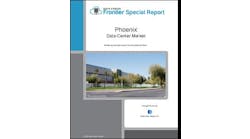Evaluating a Data Center? A Highly Interconnected Ecosystem is Key
As digital information demands continue to soar, many organizations are moving their IT infrastructure into data centers to gain greater and faster reach for transmitting huge volumes of information to their customers.
A host of factors are important in selecting a data center such as uptime, location, security, customer support and more. But among these many considerations, businesses should not overlook one of the most valuable capabilities of all – the data center’s interconnection ecosystem.
The strength of a data center system – with cloud, CDNs, network, ISPs and SaaS providers – enables customers to efficiently exchange traffic directly and privately with one-to-one or one-to-many connections with the most secure and fastest connectivity to instantly interchange data due to equipment proximity that delivers the best performance. Not only that, one of the most important aspects of an interconnected data center is carrier-neutrality. Such data centers preserve one of the most important aspects for buyers – choice. By allowing companies to choose from a variety of interconnection providers, organizations can select the best option for their business needs.
Evaluating Data Center Connectivity
In examining a data center’s ecosystem, understanding where the data center is located and how many providers, onramps and direct connections are available are key criteria. Proximity to a carrier hotel greatly increases the ecosystem and data centers that host carrier hotels have the most robust ecosystem and connection choices. The shorter the distance your data must travel to customers, the faster the data moves as well as being less expensive to transport and more secure. The only thing that reduces latency is geography and these connections are feet away versus blocks or miles.
To use an analogy, consider driving to a destination on a heavily traveled freeway. Everyone knows that it’s a lot faster to use an onramp to get to a connecting freeway than having to get off four exits down and drive side streets to get to your connection point.
The same is true for data transmission and exchange. If your data center has connections with a multitude of cloud providers, then any customer can literally plug in a cable from their organization’s server located in the data center to one of those providers within that facility - the most direct connection. This works no matter which type of provider – networks, huge content providers like Google, or major SaaS companies such as Salesforce.
By linking to a major provider in a data center, suddenly your organization has taken a significant shortcut in getting information to your customers much faster and more securely as this connection does not travel over the internet. For most organizations, this is a pivotal point.
Provider Density isn’t Everything – Consider Platform Quality
Along with the number of providers accessible through your data center, the quality of their platform is also a major factor. An uninterruptible and redundant power supply, redundant equipment, redundant distribution paths and fault-tolerant power design for the IT equipment make the environment stable. This is a telling factor regarding the data center’s quality.
Major cloud providers won’t work with a data center unless it meets certain industry standards, and criteria relating to uptime, fault tolerance and availability primarily. These standards and certifications are intended to give businesses an independent understanding of how a particular data center facility will function and what they can expect from the location. While other issues such as cost, reliability and security also play into providers’ decisions about onramp location, an enterprise looking for a premium data center would be wise to ensure it offers connectivity to an array of major cloud providers.
Multicloud Strategies Also Factor into Data Center Selection
The rate of business adoption of cloud computing continues to grow exponentially, particularly since the COVID-19 pandemic pushed remote work to new heights. Gartner predicts that public cloud end-user spending will hit nearly $500 billion in 2022. That represents a 22 percent increase over the $410.9 billion in 2021. By 2023, Gartner forecasts end-user spending to reach nearly $600 billion.
Such statistics demonstrate the rapid upward trajectory of business cloud computing, which is also leaning heavily toward multicloud strategies. According to a recent survey of cloud users by Flexera, 89 percent of respondents reported having a multicloud strategy and 80 percent are using a hybrid approach by combining use of both public and private clouds. The survey, conducted in late 2021, involved 753 global cloud decision makers and users. For organizations with a multicloud or hybrid cloud strategy, the number of cloud providers and private direct connections to them offered by a data center are important selection criteria. Data centers offering cloud provider interconnections, such as Amazon Web Services, Microsoft Azure ExpressRoute, Google Cloud Interconnect, Oracle FastConnect and IBM Direct Link 2.0, give businesses a much greater choice in finding the best cloud operators to suit their business requirements. With lower latency, better accessibility and faster throughput to meet increasing data gravity at the digital edge, customers will have instant access to the right services at the right time to meet their changing business needs.
The Number of Applications in the Cloud Grows
More and more applications are moving to the cloud, another factor to keep in mind when selecting a data center. For business leaders, this means looking at the applications your organization needs most (or plans to use in the future) and choosing a data center that gives you flexibility and choice through an ecosystem that has all of the cloud and network service providers that your business needs today and in the future.
What’s driving all this application growth? According to industry leaders, 5G, IoT, big data and dynamic content are the primary drivers. It’s not surprising considering consumers’ increasing use of cloud-based services such as streaming video, social networking and internet search, boosted by the pandemic. Business applications, among those analytics and collaboration tools, also represent a leading growth area for cloud-based applications.
Edge data centers provide the quickest content delivery to an end device that may need it, with as little latency as possible and the quick delivery of services due to the use of edge caching. Latency may be a big issue for organizations that have to work with the internet of things (IoT), big data, cloud and streaming services. Edge data centers can be used to provide high performance, low latency to end users, making for a better user experience. With gaming, users expect lightning speed as they jump through hoops and do other high jinks to win the game. They don’t want lag time or delays; they want an amazing quality experience. Edge data centers support this fast streaming content for a better customer experience.
The Need for Speed and Big Data are Fueling Hyperscale Data Center Growth
As data demand reaches astronomical heights, some businesses need the massive power required to support the servers managing, transporting and computing all of this data offered by hyperscale data centers. These centers are typically used by extremely large businesses with huge data needs, such as technology giants like Google and Microsoft. Hyperscale data centers are also becoming required for the largest social media platforms, like Facebook, Instagram and TikTok that need to reach millions if not billions of users.
The volume of data and storage capacity offered by hyperscale facilities goes far beyond the typical data center. While no official industry definition exists, hyperscale data centers are generally regarded as those exceeding 5,000 servers and an area over 10,000 square feet that can support power utilization greater than 5KW per server. High speed connectivity also is a significant requirement. Most hyperscale companies expect a connection rate of at 100 Gbps or faster.
For those that need these vast capabilities, hyperscale facilities have been crucial for business expansion and more growth is expected in this area.
In Summary
Evaluating a data center to support your IT infrastructure is complex with many factors to be considered to support your business needs. By keeping the key attributes of a quality facility in mind, such as a strong interconnection ecosystem, cloud onramps, access to carrier hotels, full redundancy and a professionally managed facility, as well as the specific IT infrastructure needs of your business, then your selection can only lead to more opportunities for growth and success.
Peg Hallberg is Head of Product and Software Engineering for Cologix. Contact Cologix to learn more about their network- and cloud- neutral colocation and digital edge data center services.






